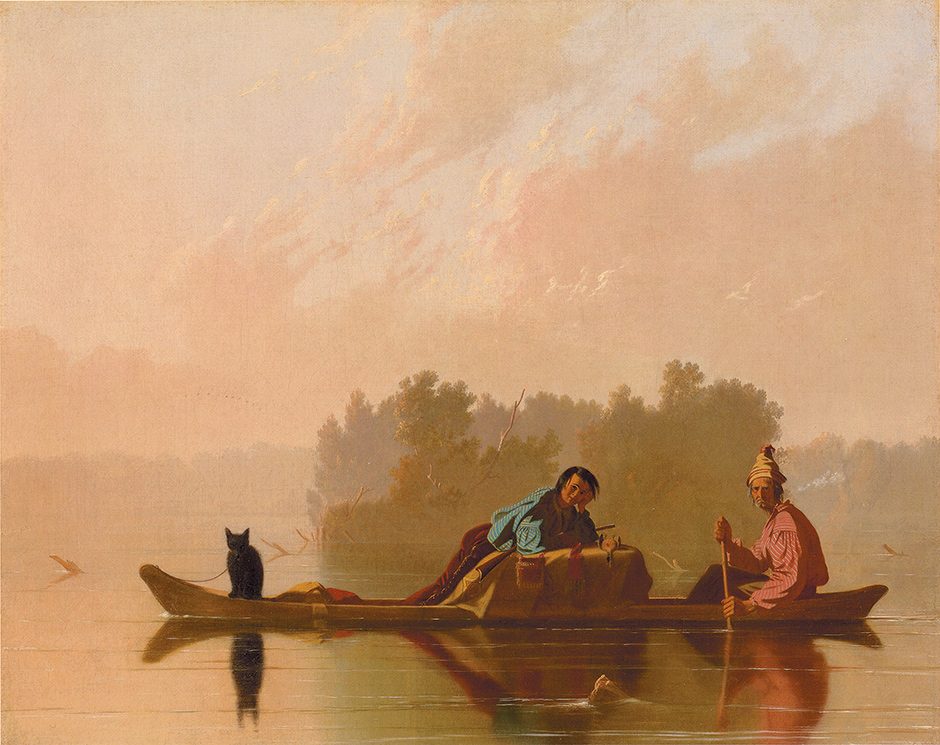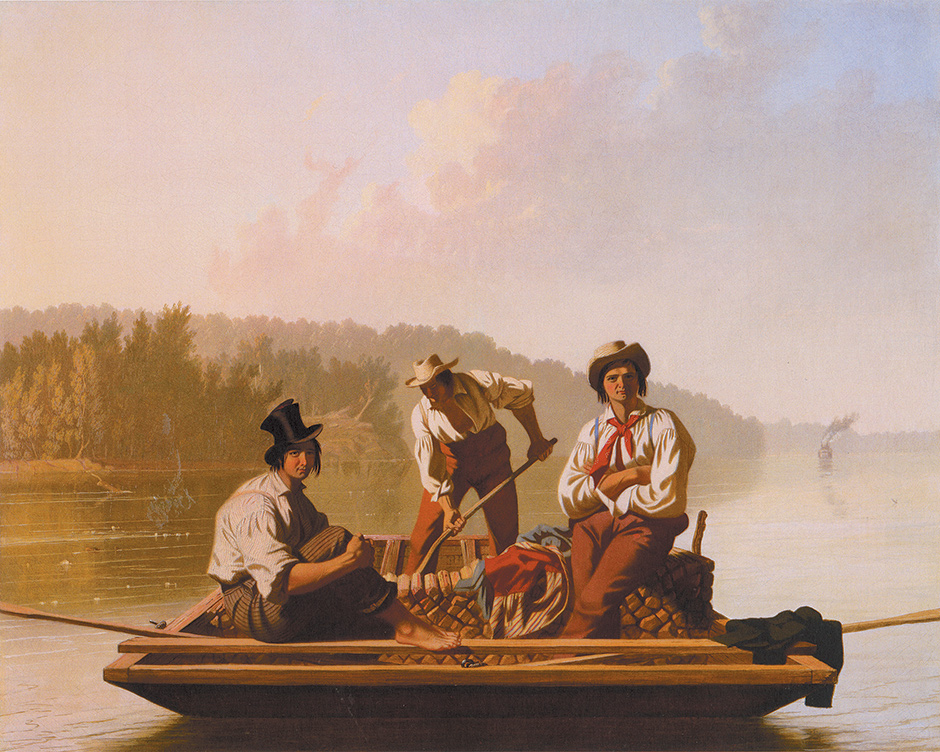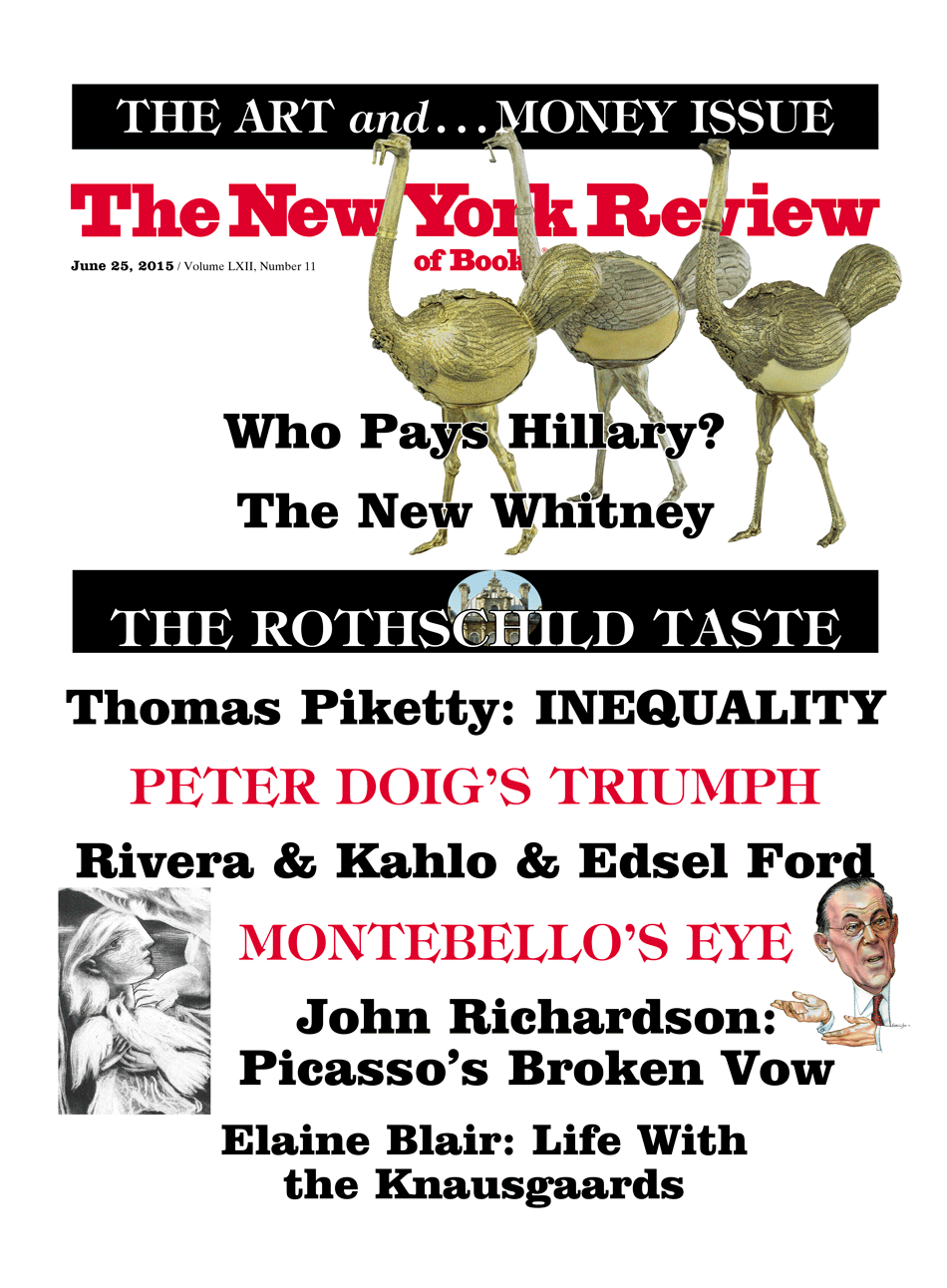There is a lovely stylishness and sense of artificiality about the paintings George Caleb Bingham made of fur traders and boatmen on the Missouri and Mississippi rivers. In pictures that date mostly from the latter half of the 1840s and seem to take place in the early hours of a summer day, we might see a wizened backwoodsman in a canoe, puffing on his pipe as he paddles by, or Bingham might show stevedores assembled on a barge, wearing jeans and maybe in their bare feet. The atmosphere has a milky-white softness, yet the light is as strong and precise as stage lighting, so that the shadows in the creases of the pants and shirts the men wear are crisply visible from a distance and attractive on their own. The very scenes seem to take place on a stage. We feel the curtain has just gone up, and there before us, on rafts so clean it seems they have been put in the water for the first time, are the cast members.
The spirit of these works, the subject of an exhibition entitled “Navigating the West: George Caleb Bingham and the River,” now at the Metropolitan Museum of Art, is clearly synthetic. We look at the work of an artist for whom balance and order are everything. In the 1847 Raftsmen Playing Cards, one of the show’s highlights, the way the men assembled on deck, in their seated, bending, and standing positions, relate to one another, and the way they relate to the quiet river world their raft is moving through, are so methodically planned out—and satisfyingly in sync—as to make the painting feel like a demonstration of sheer artistic control.
Bingham clearly thought about Raphael. Figures from the Renaissance artist’s paintings and his ideas on how to shape a composition are worked into different pictures by the Missouri-based painter. He was also perhaps aware of Poussin, whose feeling for making every aspect of a scene, starting with the arrangement of the figures, part of a grand yet compact and rock-solid design is even closer to him. What gives Bingham’s pictures their individuality, though, is the evident purity of his quest to create scenes of a classical poise—that, and his doing so with such unlikely material.
Bingham, who died in 1879, at sixty-eight, has for some time been considered one of the notable figures in the second echelon of nineteenth-century American painters. He has never been an exalted artist on the order of Winslow Homer or Thomas Eakins, in part because, like many of the painters active before the Civil War, especially the painters of people, his body of work is not extensive and the pictures of his that still speak to us are small in number. Like many of these antebellum artists, he was a fading name even before the century was over.
His rediscovery came dramatically in 1933, when Harry B. Wehle, a curator at the Met, found—in an antiques store on Madison Avenue—Fur Traders Descending the Missouri, a painting that had not been in the public eye since 1845, the year it was painted. When the picture subsequently was bought by the Met it was essentially unknown. In the years since, it has come to be seen, I think, as one of the treasures of the museum’s collection, and not merely of American painting. It is a picture whose spell you fall under.
It shows, passing by in a canoe, a somewhat gruff older man and a boy with a smile on his face. Bingham’s first title for the canvas, French Trader & Half Breed Son, provides a bit of information that the painting’s original audience, more familiar than we are with the ways of backwoodsmen, might not have found surprising. Even without this knowledge we infer a connection between them from their clothes. The father wears a pink-and-white striped shirt and has on a beanie-type cap topped with a tassel, and his son’s pants, which appear to be velvet, are purply-red and his incredible blue shirt is striped and dotted. The lustrously colored and sometimes delicately patterned clothes Bingham’s people wear, here and in others of his pictures, provide one of the special, and rarely remarked on, pleasures of his work.
The final member of the party, sitting attentively at the end of the canoe and attached to it by a little chain, is a black bear cub (often thought by viewers to be a cat). All three look out at us; and their very placement in the canoe is so perfect in itself, and they are so festive and exotic and perennially fresh to our eyes—and, not least, the way the boy lounges on the cargo, his head resting on his hand, is so unexpected and charming—that the picture seems to have in it more than it literally presents. It is as if, in the scene’s rosy-gray light, the entire American frontier past—or, simply, the past—is there before us, alive and taking our measure.
Advertisement
Fur Traders has been considered the artist’s finest work, and his paintings of river life, of which less than twenty survive, have been seen as his most poetic. The current show, which includes Fur Traders and many of Bingham’s preparatory figure drawings (and a fair amount of documentary material on river life at the time), is the first full display of the pictures. The good news is that it presents, in Raftsmen Playing Cards, a painting that, if it isn’t magical, like the Met’s picture, is certainly an unqualified success. And the 1846 Boatmen on the Missouri, which shows three men on a flatboat, two looking right at us, is fully as strong as Fur Traders, though in a different way. We don’t see enchanting storybook figures moving by in a soft light but, rather, virile young workingmen—neither, enigmatically, quite indicating his mood—in a remarkably cool-toned, green-white light. The picture is like a Fur Traders for adults. These three masterpieces came right at the beginning of Bingham’s work as a fully formed artist.
Nothing that he did after them, unfortunately, is as bracing. We see Bingham making pictures of single figures, or of a group of raftsmen passing the time with music-making, or of these men on shore, guarding cargo or conversing at night. If almost any of these paintings were seen by itself, in a room of other nineteenth-century American works, it might hold its own. None of Bingham’s contemporaries painted with his pronounced feeling for structure, and aspects of many of the pictures draw our attention: the way he compresses space, so that when a boatman is playing the fiddle his face disappears and his hat and instrument together form an abstract design; or his giving his compositions a kind of skeletal strength by emphasizing poles and fishing rods and the defining lines around boxes and barrels.
But the faces of Bingham’s figures become coarser, almost fuzzy. His handling of paint loses its porcelain sparkle and its appealing folk-art-like stiffness and becomes muddied. A second version of Fur Traders, called Trappers’ Return, from six years later, seriously pales by contrast with the first. When he made Jolly Flatboatmen in Port, in 1857, an extremely elaborate version of an earlier scene of raftsmen engaged by a dancer doing his turns, he could only be called stuck.
Bingham had subjects other than trappers and flatboatmen. He began, in the 1830s, as a portraitist in Missouri, and like numerous nineteenth-century American painters he supported himself and his family through this kind of work for much of his life. Beginning at the time of Fur Traders, when he was in his thirties, he became nationally known for his scenes of life in “the West.” When he wasn’t painting aspects of river life he might show settlers entertaining themselves with target practice, or scenes of small-town politicians making their points to fellow citizens. In time, Bingham’s energies went into a number of large-sized and ambitious political scenes—paintings of stump orators, or men in a jumble as they line up to vote.
Bingham’s concern for politics, however, went beyond subject matter for pictures. He was a politician of a sort himself. The title of the scholarly edition of his letters, from 2011, “But I Forget That I Am a Painter and Not a Politician,” catches the situation in his own words.* Even at the moment he was making a work as rich as Boatmen on the Missouri he was eyeing his chances for office. After winning a very close race for the Missouri House of Representatives, as a Whig, in 1846, and having the result overturned, he won the 1848 election and spent a term in the state capital. Thereafter, he was a man who kept himself in readiness for appointments. He was the Missouri state treasurer for much of the Civil War, and for a period he was the state’s adjutant general (and thereafter addressed as General Bingham). He went to Washington to argue a case for reparations for war damages, and he was for a time a police commissioner in Kansas City. He often thought of running for Congress or governor.
That Bingham had a kind of double life was not so unusual for an American artist in the first half or so of the nineteenth century. Finding an audience for, and making a living from, one’s art was not easy. But it was also a time when being an artist was not always sufficient even if one could support oneself that way. The generation or two that came of age in the 1820s and 1830s were well aware that they were citizens of a country that represented a new kind of political experiment in the world. The republic was roughly the same age they were—and for them being an American meant living up to a novel and expansive moment.
Advertisement
Samuel F.B. Morse, for instance, is remembered less for his portraits than for his work in developing the telegraph, while William Sidney Mount, the Long Island–based painter whose scenes of quotidian doings motivated Bingham to paint local life in Missouri, was an inventor as well. He created a structure for a traveling studio and—an able musician—he designed a new kind of violin, of which a number of examples were made. George Catlin’s project of recording what he could of certain Native American tribes, in the 1830s, resulted in his becoming, first, as he described his adventures, a considerable writer and then, when he went to London and Paris to promote a sale of his Indian portraits, a kind of anthropologist-showman.
Bingham’s case is a little like Catlin’s in that both were brilliant and original artists right from the beginning of their respective careers, and with both there is an ambiguity hovering over what happened later. One can believe that they became so fully involved in their second careers because on some level they could not take their art any further.
The center of Bingham’s art certainly fell out by the early 1850s. The picture one gets of him from most biographical accounts, particularly from Paul C. Nagel’s lively portrait in George Caleb Bingham, the catalog of the last comprehensive show of his work, held in 1990, is of a calculating person who saw success in art in strictly financial terms. When not involved in political issues or making portraits to pay the bills, he was a kind of arts entrepreneur. His paintings of small-town political oratory and voting were made, it appears, to provide the starting point for prints, which, along with prints of his earlier images of river life, he hawked somewhat the way Catlin presented Indian shows in Europe. (Nagel, it should be said, fully admires those early paintings.)
The painter doesn’t fare too well, either, in the catalog of the present show. Although his technical approaches are carefully analyzed, the vivid point of “Navigating the West” concerns Missouri. Until 1845, when Texas became part of the union, Missouri was the westernmost state, and the most engrossing part of Nenette Luarca-Shoaf’s lead essay in the catalog is less about Bingham himself than how Missourians wanted their land to appear to the rest of the country, particularly the East. Did Bingham, all of whose early, strong pictures were sold through a New York arts organization called the American Art-Union, tailor his images so that, as we read in the catalog, westerners, and the western land, would be exotic enough in appearance to lure easterners to come out in the first place, and yet well-mannered enough not to scare them off from investing once they got there?
Given Bingham’s professional concern for his state’s welfare and his belief that artistry is measured in sales, a reader puts down Luarca-Shoaf’s considered essay (which in no way seeks to disparage the painter) half-wondering whether Fur Traders and Boatmen were really just advertisements for Missouri. Bingham certainly sanitized his subjects. His raftsmen rarely do anything more demanding than push their flatboats off into the river with a pole or dance a jig. He gives them the physical bearing and leisurely composure of gods, or, at least, sportsmen. In actuality, the flatboatmen were nautical versions of gas station attendants. On their rafts they carried cords of wood, and when they weren’t hauling cargo in port their chief job was to meet the passing steamboats when called out to and supply them with fuel. They were known to be a rowdy, surly, and unkempt bunch.
Yet much as his images mesh with the way the good citizens of Missouri wanted their state to be seen, Bingham’s best work has a life of its own. One feels that his lack of realism about backwoodsmen and raftsmen and the rivers themselves had less to do with not wanting his images to offend than with a lack of interest in the appearance of actual, everyday life to begin with. His art came out of a studious, almost innocent, regard for past artistic achievement. His one period of serious art education came when, in 1838, he spent three months in Philadelphia, at the Pennsylvania Academy, where he studied engravings of Old Master art and drew from casts of antique sculpture. He brought what prints, drawings, and casts he could back to Missouri, and their presence, along with drawings he made in his studio of acquaintances dressed as raftsmen, trappers, and other local types, were the foundation of his paintings.
His figures were concoctions, and the most successful may be the seated young fellow in Boatmen on the Missouri. With one knee up and his arm around it, and his head turned to look at us—and with his scraggly long hair and suspenders, his striped pants and striped shirt, and, best of all, a top hat that is broken open at the top—he has an offhandedly elegant presence. He could easily pass for a counterculture demonstrator or a member of a music or theater group from any of the last few decades, maybe most the 1960s. As a figure, he derives, I believe, from a detail in a once-well-known print after Raphael’s The Judgment of Paris. The detail shows a water nymph seated with two river gods, and the nymph, with some adjusting of the arm, appears to have provided the inspiration for Bingham’s raftsman.
If this figure seems familiar it may be because Manet, some fifteen years after Bingham, made the detail of the nymph (and the water gods) the basis of his once-scandalous painting Le déjeuner sur l’herbe. There the nymph is a startlingly naked woman who is staring at us, and the water gods have become two well-dressed Parisian men. The thought of Bingham being on the same wavelength as Manet of all people, and as beating the French painter to the use of this image—and of having the wit to turn a nymph into a stevedore—tickles the mind. Levelheaded in his gaze, and as lovable as he is vaguely insolent, Bingham’s young man embodies his maker’s art at its all too brief best.
-
*
“But I Forget That I Am a Painter and Not a Politician”: The Letters of George Caleb Bingham, edited by Lynn Wolf Gentzler and compiled by Roger E. Robinson (State Historical Society of Missouri/Friends of Arrow Rock Inc., 2011). ↩




